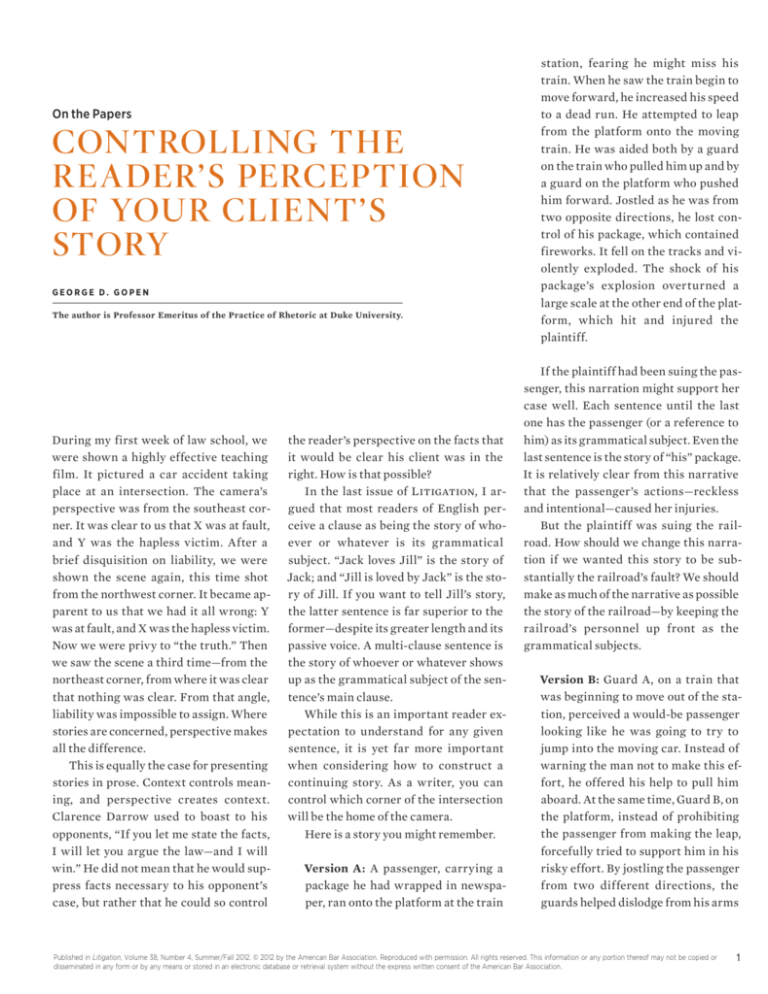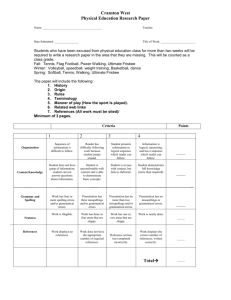
On the Papers
Controlling the
R ea der’s Perception
of Your Client’s
Story
George D. Gopen
The author is Professor Emeritus of the Practice of Rhetoric at Duke University.
During my first week of law school, we
were shown a highly effective teaching
film. It pictured a car accident taking
place at an intersection. The camera’s
perspective was from the southeast corner. It was clear to us that X was at fault,
and Y was the hapless victim. After a
brief disquisition on liability, we were
shown the scene again, this time shot
from the northwest corner. It became apparent to us that we had it all wrong: Y
was at fault, and X was the hapless victim.
Now we were privy to “the truth.” Then
we saw the scene a third time—from the
northeast corner, from where it was clear
that nothing was clear. From that angle,
liability was impossible to assign. Where
stories are concerned, perspective makes
all the difference.
This is equally the case for presenting
stories in prose. Context controls meaning, and perspective creates context.
Clarence Darrow used to boast to his
opponents, “If you let me state the facts,
I will let you argue the law—and I will
win.” He did not mean that he would suppress facts necessary to his opponent’s
case, but rather that he could so control
the reader’s perspective on the facts that
it would be clear his client was in the
right. How is that possible?
In the last issue of Litigation, I argued that most readers of English perceive a clause as being the story of whoever or whatever is its grammatical
subject. “Jack loves Jill” is the story of
Jack; and “Jill is loved by Jack” is the story of Jill. If you want to tell Jill’s story,
the latter sentence is far superior to the
former—despite its greater length and its
passive voice. A multi-clause sentence is
the story of whoever or whatever shows
up as the grammatical subject of the sentence’s main clause.
While this is an important reader expectation to understand for any given
sentence, it is yet far more important
when considering how to construct a
continuing story. As a writer, you can
control which corner of the intersection
will be the home of the camera.
Here is a story you might remember.
Version A: A passenger, carrying a
package he had wrapped in newspaper, ran onto the platform at the train
station, fearing he might miss his
train. When he saw the train begin to
move forward, he increased his speed
to a dead run. He attempted to leap
from the platform onto the moving
train. He was aided both by a guard
on the train who pulled him up and by
a guard on the platform who pushed
him forward. Jostled as he was from
two opposite directions, he lost control of his package, which contained
fireworks. It fell on the tracks and violently exploded. The shock of his
package’s explosion overturned a
large scale at the other end of the platform, which hit and injured the
plaintiff.
If the plaintiff had been suing the passenger, this narration might support her
case well. Each sentence until the last
one has the passenger (or a reference to
him) as its grammatical subject. Even the
last sentence is the story of “his” package.
It is relatively clear from this narrative
that the passenger’s actions—reckless
and intentional—caused her injuries.
But the plaintiff was suing the railroad. How should we change this narration if we wanted this story to be substantially the railroad’s fault? We should
make as much of the narrative as possible
the story of the railroad—by keeping the
railroad’s personnel up front as the
grammatical subjects.
Version B: Guard A, on a train that
was beginning to move out of the station, perceived a would-be passenger
looking like he was going to try to
jump into the moving car. Instead of
warning the man not to make this effort, he offered his help to pull him
aboard. At the same time, Guard B, on
the platform, instead of prohibiting
the passenger from making the leap,
forcefully tried to support him in his
risky effort. By jostling the passenger
from two different directions, the
guards helped dislodge from his arms
Published in Litigation, Volume 38, Number 4, Summer/Fall 2012. © 2012 by the American Bar Association. Reproduced with permission. All rights reserved. This information or any portion thereof may not be copied or
disseminated in any form or by any means or stored in an electronic database or retrieval system without the express written consent of the American Bar Association.
1
a package he was carrying, wrapped
in newspaper. Their actions caused
the package, which contained fireworks, to fall several feet to the tracks,
where it exploded. The resulting
shock overturned a large scale at the
other end of the platform, which hit
and injured the plaintiff.
From this continued perspective of
the railroad employees, we get a strikingly different story. The guards—as subjects of those verbs—are doing all the
problematic actions. In English, we read
from left to right and through time.
Whatever we encounter on the left contextualizes whatever we discover to its
right. This story is slanted against the
railroad, in the same way Version A was
slanted against the passenger.
We could slant the story in favor of the
plaintiff if we were to present each of the
details from her perspective—by making
her the grammatical subject as continuously as possible.
Version C: The plaintiff was waiting
for her train to arrive, standing on the
platform next to a large weighing
scale. She noted a commotion developing at the other end of the platform
as a train began its exit from the station. She saw a would-be passenger
trying to leap aboard the moving
train, with the guards on the platform
and on the train attempting to help
him. She noticed the passenger’s
package drop to the tracks—and then
was overwhelmed by the sounds and
sights of a huge explosion. Suddenly
she felt a great weight crack against
her head and shoulders as she crumpled to the ground under the overturned scale. She remained there in
great pain, pinned by the heavy scale,
until rescued.
You may remember Miss Grundy, your
middle school English teacher, admonishing you to vary the way you begin your
sentences to keep your reader interested.
Perhaps that was good advice back then;
it is very bad advice for you now. Back
then, your reader was primarily (and
maybe exclusively) Miss Grundy. As
You can control which
corner of an intersection
will be the home of
the traffic camera.
wonderful as she might have been, there
was no way she could possibly be interested in 42 essays on “Why I Like the
Spring,” with their topic sentences, their
conclusions, and their compulsory list of
three examples:
“I like the spring because of the pretty
flowers. I like the spring because of the
tulips. I like the spring because of the
roses. I like the spring because of the daffodils. I like the spring because of the
pretty flowers.”
She didn’t mean “interested”; she
meant “sane.” “‘Daffodils are another
reason I like the spring.’ Vary the way
you begin your sentences to keep me
from going insane!”
You do not have to keep your reader
interested. Your reader is being paid to
read you. You need to keep your reader
controlled. Keep the grammatical subjects of your sentences the same for as
long as you are telling that particular
story. Then, by changing whose story the
next sentence is, you will (silently) convey to your reader, “. . . and now we are
changing the focus of our attention to
this next story.”
When Judge Cardozo wrote the facts
into his opinion in Palsgraf v. Long Island
Railroad, 248 N.Y. 339, 162 N.E. 99 (N.Y.
1928), he did not try to slant the reader’s
perception in an adversarial manner.
Instead, he presented the actions as having a number of different agents—spreading whose story it was appropriately over
everybody. That left open the question of
responsibility, which he would then discuss. Here is his narration, with the
grammatical subjects italicized:
Version D: Plaintiff was standing on a
platform of defendant’s railroad after
buying a ticket to go to Rockaway
Beach. A train stopped at the station,
bound for another place. Two men ran
forward to catch it. One of the men
reached the platform of the car without mishap, though the train was already moving. The other man, carrying a package, jumped aboard the car,
but seemed unsteady as if about to fall.
A guard on the car, who had held the
door open, reached forward to help
him in, and another guard on the platform pushed him from behind. In this
act, the package was dislodged, and
fell upon the rails. It was a package of
small size, about fifteen inches long,
and was covered by a newspaper. In
fact it contained fireworks, but there
was nothing in its appearance to give
notice of its contents. The fireworks
when they fell exploded. The shock of
the explosion threw down some
scales at the other end of the platform,
many feet away. The scales struck the
plaintiff, causing injuries for which
she sues.
Palsgraf, 248 N.Y. at 340–41.
It is the judge’s job to consider everybody’s and everything’s story, knit together in the logical and chronological
way that makes the best sense. It is an
advocate’s job to tell the story as fetchingly from the client’s perspective as possible. Control whose story it is at all times,
and you control the perspective from
which the reader perceives that story. q
Published in Litigation, Volume 38, Number 4, Summer/Fall 2012. © 2012 by the American Bar Association. Reproduced with permission. All rights reserved. This information or any portion thereof may not be copied or
disseminated in any form or by any means or stored in an electronic database or retrieval system without the express written consent of the American Bar Association.
2







